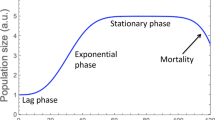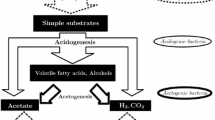Abstract
Thermodynamic models can be used to predict bacterial yields and develop stoichiometric representation of biological reactions in the absence of empirical data. Several methods have been used by microbiologists, biotechnologists, and environmental engineers. This manuscript illustrates that these formulations are related. Yields predicted by estimation of Gibbs energy of dissipation and yields predicted by assumed efficiency of energy capture are comparable. Direct comparison of yield predictions from different methods shows the effects of assumptions inherent in the methodologies. Mathematical relationships between estimated values from the different methods help identify the best predictionsfrom each method to bound the estimate of bacterial yield.
Similar content being viewed by others
References
Alvarez PJJ, Anid PJ & Vogel TM (1994) Kinetics of toluene degradation by denitrifying aquifer microorganism. J. Environ. Engng 120(5): 1327-1337
Arcangeli J-P & Arvin E (1999) Modeling the growth of a methanotrophic biofilm: Estimation of parameters and variability. Biodegradation 10: 177-191
Banaszak, JE, Rittmann BE, VanBriesen JM & Reed DT (2002) Mathematical modeling of precipitation and dissolution reactions in microbiological systems. Accepted in Biodegradation
Bedient PB, Long GP & Rifai HS (1992) Modeling natural biodegradation with bioplume II. Proceedings of the Fifth International Conference on the use of models to analyze and find working solution to ground water problems: solving ground water problems with models
Bedient PB & Rifai HS (1992) Ground water contamination modeling for bioremediation: a review. J. Hazard. Mater. 32: 255-263
Beller HR, Spormann AM, Sharma PK, Cole JR & Reinhard M (1996) Isolation and characterization of a novel toluenedegrading, sulfate-reducing bacterium. Appl. Environ. Microbiol. 62(4): 1188-1196
Blanch HW & Clark DS (1997) Biochemical Engineering. Marcel Dekker, Inc., New York
Bordon RC & Bedient PB (1986) Transport of dissolved hydrocarbons influenced by O2 limited biodegredation 2: field application. Water Resour. Res. 22(13): 1983-1990
Burland, S & Edwards EA (1999) Anaerobic benzene biodegradation linked to nitrate reduction. Appl. Environ. Microbiol. 65(2): 529-533
Chen GH & Liu Y (1999) Modeling of energy spilling in substrate sufficient cultures. J. Environ. Engng-ASCE 125(6): 508-513
Christensen DR & McCarty PL (1975) Multi-process biological treatment model. J.Water Pollut. Contr. Fed. 47(11): 2652-2664
Corseuil HX & Weber WJ (1994) Potential biomass limitations on rates of degradation of monoaromatic hydrocarbons by indigenous microbes in subsurface soils. Water Res. 28(6): 1415-1423
Doran PM (1995.) Bioprocess Engineering Principles. Academic Press, New York
Edwards EA & Grbic-Galic D (1994) Anaerobic degradation of toluene and o-xylene by a methanogenic consortium. Appl. Environ. Microbiol. 60(1): 313-322
Erickson LE (1979a) Application of mass and energy balance regularities in fermentation processes. Annals of the New York Academy of Sciences 326: 73-85
Erickson LE (1979b) Energetic efficiency of biomass and product formation. Biotechnol. Bioengng 21: 725-743
Erickson LE (1981) Energetic yields associated with hydrocarbon fermentations. Biotechnol. Bioengng 23: 793-803
Erickson LE & Hess JL (1981) Analysis of growth and polysaccharide yields in chemostat cultures of Rhizobium trifolii. Annals of the New York Academy of Sciences 369: 81-89
Erickson LE, Minkevich IG & Eroshin VK (1978) Application of mass and energy balance regularities in fermentation. Biotechnol. Bioengng 20: 1595-1621
Erickson LE, Minkevich IG & Eroshin VK (1979) Utilization of mass-energy balance regularities in the analysis of continuousculture data. Biotechnol. Bioengng 21: 575-591
Ferrer A & Erickson LE (1979) Evaluation of data consistency and estimation of yield parameters in hydrocarbon fermentations. Biotechnol. Bioengng 21: 2203-2233
Frind EO et al. (1990) Modeling of multicomponent transport with microbial transformation in ground water: the Fuhrberg case. Water Resour. Res. 26(8): 1707-1719
Gerhardt P & Drew SW (1994) Liquid culture. In: Gerhardt P, Murray RGE, Wood WA & Krieg NR (Eds) Methods for General and Molecular Bacteriology (pp 224-247). American Society for Microbiology, Washington DC
Grosz R & Stephanopoulos G (1983) Statistical mechanical estimation of the free-energy of formation of Escherichia coli biomass for use with macroscopic bioreactor balances. Biotechnol. Bioengng 25: 2149
Hayes AM, Flora JRV & Khan J (1998) Research note: electrolytic stimulation of denitrification in sand columns. Water Res. 32(9): 2830-2834
Heijnen JJ (1991) A new thermodynamically based correlation of chemotrophic biomass yields. Antonie Van Leeuwenhoek 60: 235-256
Heijnen JJ (1994) Thermodynamics of microbial growth and its implications for process design. Trends in Biotechnol. 12: 483-492
Heijnen JJ (1999) Bioenergetics of microbial growth. In: Flickinger MC & Drew SW(Eds) Encyclopedia of Bioprocess Technology: Fermentation, Biocatalysis, and Bioseparation. John Wiley and Sons, Inc., New York
Heijnen JJ & Roels JA (1981) A macroscopic model describing yield and maintenance relationships in aerobic fermentation processes. Biotechnol. Bioengng 23: 739-763
Heijnen JJ & van Dijken JP (1992) In search of a thermodynamic description of biomass yields for the chemotrophic growth of microorganisms. Biotechnol. Bioengng 39: 833-858
Heijnen JJ & van Dijken JP (1993) Response to comments on: in search of a thermodynamic description of biomass yields for the chemotrophic growth of microorganisms. Biotechnol. Bioengng 42: 1127-1130
Heijnen JJ., van Loosdrecht MCM & Tijhuis L (1992) A black box mathematical model to calculate auto-and heterotrophic biomass yields based on Gibbs energy dissipation. Biotechnol. Bioengng 40: 1139-1154
Herbert D, Elsworth R & Telling RC (1956) The continuous culture of bacteria: A theoretical and experimental study. J. Gen. Microbiol. 14: 601-622
Hooker BS, Skeen RS & Petersen JR (1994) Biological destruction of CCl4: II. Kinetic modeling. Biotechnol. Bioengng 44: 211-218
Lawrence AW & McCarty PL (1970) Unified basis for biological treatment design and operation. ASCE J. Sanit. Engng Div. 96(nSA3): 757-778
Lee HY, Erickson LE & Yang SS (1984) The estimation of growth yield and maintenance parameters for photoautotrophic growth. Biotechnol. Bioengng 26: 926-935
Linton JD & Stephenson RJ (1978) A preliminary study on growth yields in relation to the carbon and energy content of various organic growth substrates. FEMS Microbiol. Lett. 3: 95-98
MacQuarrie KTB, Sudicky EA & Frind EO (1990) Simulation of biodegradable organic contaminants in ground water 1: numerical formulation in principal direction. Water Resour. Res. 26(2): 207-222
Mavrovouniotis ML (1990) Group contributions for estimating standard Gibbs energies of formation of biochemical compounds in aqueous solution. Biotechnol. Bioengng 36: 1070-1082
Mavrovouniotis ML (1991) Estimation of standard Gibbs energy changes of biotransformations. J. Biol. Chem. 266: 14440-14445
McCarty PL (1965) Thermodynamics of biological synthesis and growth. In: Baers J (Ed) Advances in Water Pollution Research: Proceedings of the 2nd International Conference on Water Pollution Research (pp 169-199). Vol. 2. Pergamon Press, Inc., Oxford, England
McCarty PL (1969) Energetics and Bacterial Growth. The Fifth Rudolf Research Conference
McCarty PL (1971) Energetics and bacterial growth. In: Hunter SD & Faust JV (Eds) Organic Compounds in Aquatic Environments. Marcel Dekker, Inc., New York
McCarty PL (1972a) Energetics of organic matter degradation. In: Mitchell Ralph (Ed) Water Pollution Microbiology. Wiley-Interscience, New York
McCarty PL (1972b) Stoichiometry of biological reactions. Paper presented at the International Conference toward a Unified Concept of Biological Waste Treatment Design.
McCarty PL (1975) Stoichiometry of biological reactions. Progress in Water Technology 7: 157-172.
McNabb WW Jr. & Narasimhan TN (1994) Modeling reactive transport of organic compounds in groundwater using a partial redox disequilibrium approach. Water Resour. Res. 30(9): 2619-2635
Metcalf & Eddy, Inc. (1991) Wastewater Engineering: Treatment, Disposal, and Reuse. McGraw-Hill Inc., New York
Minkevich IG & Eroshin VK (1973) Productivity and heat generation of frementation under oxygen limitation. Folia Microbiologica 18: 376-385
Noguera DR, Araki N & Rittmann (1994) Soluble microbial products (SMP) in anaerobic chemostats. Biotechnol. Bioengng 44: 1040-1047
Noguera DR, Brusseau GA, Rittmann BE & Stahl DA (1988) A unified model describing the role of hydrogen in the growth of desulfovibrio vulgaris under different environmental conditions. Biotechnol. Bioengng 59: 732-746
Oner MD, Erickson LE & Yang SS (1984) Estimation of yield, maintenance, and product formation kinetic parameters in anaerobic fermentations. Biotechnol. Bioengng 26: 1436-1444
Pirt SJ (1965) The maintenance energy of bacteria in growing cultures. Proceedings of the Royal Society of London 163B: 224-231
Pronk JT, Meesters PJW, van Dijken JP, Bos P & Kuenen JG (1990) Heterotrophic growth of Thiobacillus acidophilus in batch and chemostat cultures. Arch. Microbiol. 153: 392-398
Reardon KF, Mosteller DC & Rogers JDB (2000) Biodegradation kinetics of benzene, toluene, and phenol as single and mixed substrates for Pseudomonas putida F1. Biotechnol. Bioengng 69(4): 385-400
Rittmann BE & McCarty PL (2001) Environmental Biotechnology: Principles and Applications. McGraw-Hill Book Company, New York
Rittmann BE & VanBriesen JM (1996) Microbiological processes in reactive modeling. In: Lichtner PC, Steefel CI & Oelkers EH (Eds) Reviews in Mineralogy, Vol. 34: Reactive Transport in Porous Media (p 311). Mineralogical Society of America
Roels JA (1980) Application of macroscopic principles to microbial metabolism. Biotechnol. Bioengng 22: 2457-2514
Roels JA (1983) Energetics and Kinetics in Biotechnology. Elsevier, Amsterdam
Roels JA (1987) Thermodynamics of growth. In: Kristiansen J & Bu'Lock B (Eds) Basic Biotechnology. Academic Press, New York
Roels JA (1993) Comments on: in search of a thermodynamic description of biomass yields for the chemotrophic growth of microorganisms. Biotechnol. Bioengng 42: 1124-1126
Rutgers M (1990) Control and Thermodynamics of Microbial Growth. University of Amsterdam
Rutgers M, van der Gulden HML & vanDam K (1989) Thermodynamic efficiency of bacterial growth calculated from growth yield of pseudomonas oxalaticus OX1 in the chemostat. Biochim. Biophys. Acta 973: 302-307
Schrodinger E (1944) What Is Life? The Physical Aspects of a Living Cell. Cambridge University Press, Cambridge
Solomon BO, Erickson LE, Hess JE and Yang SS (1982) Maximum likelihood estimation of growth yields. Biotechnol. Bioengng 24: 633-649
Stouthamer AH (1988) Bioenergetics and yields with electron acceptors other than oxygen. In: Erickson LE and Yee-Chank Fund D (Eds) Handbook on Anaerobic Fermentation (pp 345-427).
Marcel Dekker, New York Stull DR, Westrum Jr EF & Sinke GC (1969) Chemical Thermodynamics of Organic Compounds. John Wiley and Sons, Inc., New York
Stumm W & Morgan JJ (1996) Aquatic Chemistry. 3rd edn. Wiley Interscience, New York
Thauer RK, Jungermann & Decker K (1977) Energy conservation in chemotrophic anaerobic bacteria. Bacteriol. Revs. 41: 100-180
Tijhuis, L, van Loosdrecht MCM & Heijnen JJ (1993) A thermodynamically based correlation for maintenance Gibbs energy requirements in aerobic and anaerobic chemotrophic growth. Biotechnol. Bioengng 42: 509-519
VanBriesen JM (2001) Thermodynamic yield predictions for biodegradation through oxygenase activation reactions. Biodegradation 12: 265-281
VanBriesen JM & Rittmann BE (2000a) Mathematical description of microbiological reactions involving intermediates. Biotechnol. Bioengng 67(1): 35-52
VanBriesen JM & Rittmann BE (2000b) Modeling speciation effects on biodegradation in mixed metal/chelate systems. Biodegradation 10: 315-330
VanBriesen JM, Rittmann BE, Girvin & Bolton Jr H (2000) The rate-controlling substrate form for the biodegradation of nitrilotriacetate by Chelatobacter heintzii. Environ. Sci. Technol. 34: 3346-3353
van Loosdrecht M, Dircks K, Beun J & Heijnen J (2000) Discussion of: modeling of energy spilling in substrate sufficient cultures. J. Environ. Engng-ASCE 126(10): 979-980
van Verseveld HW (1979) Influence of Environmental Factors on the Efficiency of Energy Conservation in Paracoccus denitrificans. Free University of Amsterdam
Verduyn C, Stouthamer AH, Scheffers A & van Dijken JP (1991) A theoretical evaluation of growth yields of yeasts. Antonie Van Leeuwenhoek 59: 49-63
von Stockar U & Liu J-S: 1999 Does microbial life always feed on negative entropy? Thermodynamic analysis of microbial growth. Biochimica Et Biophysica Acta 1412: 191-211
Walter AL, Frind EO, Blowes DW et al. (1994) Modeling of multicomponent reactive transport in ground water 1: model development and evaluations. Water Resour. Res. 30(11): 3137-3148
Westerhoff HV, Hellingwerf KJ & van Dam K (1983) Thermodynamic efficiency of microbial growth is low but optimal for maximum growth rate. Proceedings of National Academy of Sciences 80: 305-309
Westerhoff HV & vanDam K (1987) Thermodynamics and Control of Biological Free-Energy Transduction. Elsevier, New York
Woo SH & Rittmann BE (2000) Microbial energetics and stoichiometry for biodegradation of aromatic compounds involving oxygenation reactions. Biodegradation 11(4): 213-227
Yuan Z & VanBriesen J (2002) Yield prediction and stoichiometry of multi-step biodegradation reactions involving oxygenation. Biotechnol. Bioengng 80(1): 100-113
Zitomer DH (1998) Stoichiometry of combined aerobic and methanogenic COD transformation. Water Res. 32(3): 669-676
Author information
Authors and Affiliations
Rights and permissions
About this article
Cite this article
VanBriesen, J.M. Evaluation of methods to predict bacterialyield using thermodynamics. Biodegradation 13, 171–190 (2002). https://doi.org/10.1023/A:1020887214879
Issue Date:
DOI: https://doi.org/10.1023/A:1020887214879




